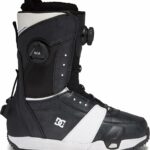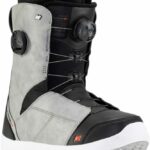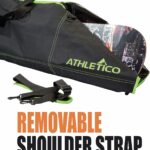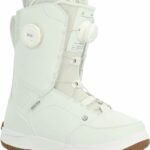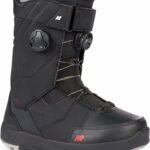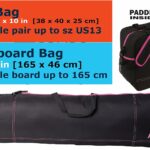Strapping in for your next slope adventure but unsure about which snowboard boot size suits you best? This article is a godsend for you! It will guide you through the process of picking just the right size for your snowboard boots, ensuring you achieve comfort and optimize your performance on the icy playground. And while size matters greatly, you’ll also learn why the perfect fit is about much more than just a number. Get ready for a stride-by-stride walkthrough to finding your ‘solemate’.
Understanding the importance of perfect fit
Snowboarding requires finesse, balance and of course, the perfect gear. One of the most crucial elements of that gear is your snowboard boots. Finding the right fit isn’t just about comfort, it can radically affect your lifts, turns, landings, and overall performance on the slopes.
Implication of ill-fitting boots
Firstly, let’s discuss what happens when your snowboard boots don’t fit correctly. Ill-fitting boots can result in discomfort and pain, not to mention foot cramps and major blisters. These issues can distract you from enjoying your ride and even affect your safety. Moreover, the wrong snowboard boots can negatively affect your progress and performance in the sport.
Performance impact of improper size boots
Liked it or not, snowboarding is a sport where millimeters matter. In shoes that are too large, your foot will have room to slide which can lead to loss of control when maneuvering your board. On the other hand, boots that are too tight may restrict your movement and limit your control over the snowboard. Wrong-sized boots also tend to distort your balance, which is a key to effective snowboarding.
Comfort factor and its relation with boot size
Comfort is key in snowboarding, the more comfortable you are, the longer and better you can perform. Poorly fitted boots can create pressure points that cause discomfort, while boots that are too big can needlessly tire you out as your feet compensate for the extra space. A proper fit helps you stay comfortable and focused, improving your overall snowboarding experience.
Knowing your exact foot size
How to measure foot size at home
Getting your foot measurement is an essential step in finding the right boot size. You can do this easily at home by standing on a sheet of paper and tracing the outline of your foot. Then, measure the length from the heel to the longest toe, and the width at the widest part of your foot.
The role of shoe size in determining boot size
Shoe size is a good starting point in determining your boot size. Most snowboard boot manufacturers use the same sizing as your regular shoe size. However, it’s important to remember that shoe sizes can vary between brands and styles, so it’s always best to try on boots whenever possible.
Common mistakes while measuring foot size
A common mistake is measuring your foot size in the wrong position. You should be standing up, since your foot expands under your weight. Also, don’t forget to measure your foot later in the day, when it tends to be at its largest. Another mistake is not wearing the same socks while measuring that you’d wear while snowboarding.
Decoding snowboard boot sizes
How snowboard boot sizes are measured
Snowboard boot sizes are typically measured in mondopoints, which are millimeters. This measurement system provides a more exact size than traditional shoe sizes and allows for a better fit.
Understanding mondo point size system
The mondo point sizing system is based on the length of the foot in centimeters. So, to find your mondo point size, simply convert your measurement to centimeters. Keep in mind that snowboard boots are manufactured in half-size increments, so round up or down accordingly.
Relation between shoe size and boot size
Generally, your snowboard boot size will directly correlate to your shoe size. But remember, it’s not always an exact match due to differences in brands and styles. Therefore, it’s important to know your mondo size and compare it to the manufacturer’s size chart.
Trying on the boots correctly
Importance of trying before buying
Even with your precise foot measurements, it’s crucial that you always try on boots before buying them. The feel of the boot on your foot is the ultimate test of proper fit. Also, this can give you a chance to spot any potential issues that might affect your comfort or performance.
Factors to consider when trying on snowboard boots
When you’re trying on boots, pay attention to the overall fit, lacing system, and fit around your heel, ankle, and calf. You should be able to flex forward without feeling any pinching or binding. Your foot should feel snug but not tight, with toes brushing against the end of the boot.
Common fitting problems and how to detect them
Common fitting issues include pressure points, too much heel lift, or toes that are cramped up. You want to look for a snug fit, but if you feel pressure or rubbing on specific points, the boot is probably not the right fit for you.
Checking the fit of snowboard boots
How a right fit boot should feel
A rightly fitted boot should feel snug, but not too tight. Your toes should touch the end of the boot when standing upright and pull back slightly when you flex your knees. Your heel needs to stay firmly in place when you stand up or flex.
Understanding positions – Heels, Toes, Ankles
The position of your heels, toes, and ankles plays a key role down to your performance. Your heel should remain steady in the boot, whether you’re standing or flexing. Your toes, on the other hand, should be able to move slightly. Lastly, your ankles, which transfer your movements to the board, should not feel pinched.
Dealing with pressure points and snug fits
If there is too much pressure on a certain area, it may cause discomfort or affect control over your snowboard. Alternatively, a fit that’s too snug can cause circulation issues. Always keep a close eye on these potential fit problems.
Making sense of flex in snowboard boots
What is boot flex and why does it matter
Boot flex refers to the stiffness or softness of the boot. It impacts your board response, turn initiation, and control. The flex fit you need will largely depend on your riding style and skill level.
How boot size affects flex
Larger boots typically come with more materials, making them stiffer. Meanwhile, smaller boots are usually softer due to less material used. So, having an appropriately-sized boot is crucial to finding the flex that suits you.
Finding the right flex based on snowboarding style
If you’re a beginner, a softer flex is easier to maneuver and forgiving of mistakes. More experienced riders may prefer a stiffer boot for quicker response. On the other hand, if you enjoy freestyling or backcountry riding, you may want a medium to stiffer flex to help manage varied terrain.
The role of snowboard boot liners
What are boot liners and their purpose
Boot liners are the layer between your foot and the hard shell of your snowboard boot. They provide padding, insulation, and play a major part in the boots’ fit and comfort.
Significance of liners in boot-sizing
A good liner contributes significantly to the boot’s overall fit. Liners come in different volumes, which can result in a different fit even between boots of the same size. It’s crucial to remember this when choosing boot sizes.
Heat molding liners for a perfect fit
Some liners can be heat molded for a perfect fit. This is done by heating the liners, wearing them for a while, and letting them cool down, resulting in a mold that exactly fits your feet. If available, heat molding is a way to get a truly custom fit.
Choosing snowboard boots based on riding style
How your riding style impacts boot choice
Your riding style greatly impacts the type of boot that’s right for you. Freeride snowboarders may prefer a stiffer boot for more control at high speeds. Freestylers might lean towards a softer flex for better maneuverability, and all-mountain riders generally need a medium flex for versatility.
Boot characteristics for different riding styles
Different riding styles call for different boot characteristics. Stiffer boots provide stability and faster response time, beneficial for freeriding. Meanwhile, softer boots are flexible and forgiving, perfect for freestyle riding.
Why boot size can be different for different styles
The preferred size often varies slightly between different riding styles to accommodate various boot characteristics. For instance, a freestyler might opt for a tighter fit for more control over tricks, whereas a casual all-mountain rider might prioritize a roomier fit for comfort.
Considering the brand factor
Variations in boot sizing across brands
Brand sizing can vary significantly. Some brands might run larger, while others are known to run smaller. It’s important to keep this in mind when you’re referring to the size charts of different brands.
Brands known for differing from standard sizes
Certain brands, like Burton and K2, are known to run true to size, while others like Salomon and Ride may run smaller. However, these are general trends, and the fit can also vary based on the specific boot model.
Finding the right size in your preferred brand
Knowing your preferred brand’s quirks can save you time and effort. Always compare your foot measurements or shoe size with the sizing chart of your preferred brand. Don’t be afraid to deviate from your standard shoe size if it means getting the right fit.
Finding the right insoles for your snowboard boots
Importance of insoles in boot sizing
Insoles play a huge role in boot fit and foot comfort. A good insole can correct poor boot fit, offer better support, and absorb shocks better, making your ride more comfortable and controlled.
Selecting insoles based on foot arch type
Your arch type (flat, normal, or high) will determine the type of support you need from an insole. Make sure you choose insoles that provide the right kind of arch support for your feet.
How to fit insoles into snowboard boots
First, remove the existing insoles in your boots. Then, place your new insole against the old one to compare sizes. Trim the new insole if required, using the old insole as a guide. Lastly, insert your new insoles into your boots and press them down into position.
It might take some effort and time to find the perfect snowboard boots, but remember, your boots are your connection to the snowboard and ultimately the mountain. So it’s worth investing that time to get a perfect fit. Happy shredding!
- What Snowboard Bindings Should I Get? - January 23, 2024
- What Size Screws For Snowboard Bindings? - January 23, 2024
- How To Snowmobile On Water? - January 23, 2024


